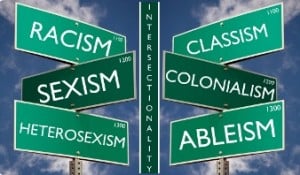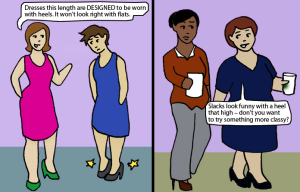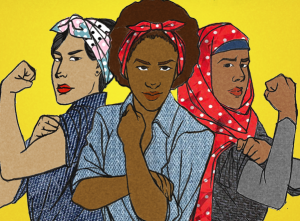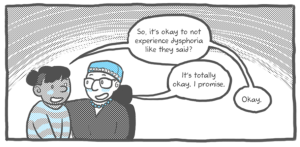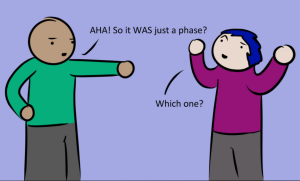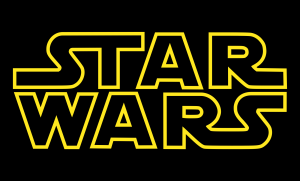
Source: Wikipedia
Author’s Note:The following critique is based on the first six Star Wars movies – and the movies alone. If progressive elements of the Star Wars universe exist outside of the films, they need to be integrated into the cash cow of cinema, without which there would be no Star Wars universe.
The upcoming Star Wars film, The Force Awakens, recently topped Avengers 2 as the most anticipated movie of 2015.
At the time of writing, its first official teaser trailer had already tallied over 55 million hits on YouTube. And with the opening image of a Black Stormtrooper, racists across the country have made their displeasure known.
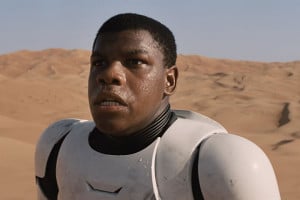
Supporters of this new image immediately rallied around the #blackstormtrooper hashtag, drowning out these racist voices.
However, the vocal resistance to potentially positive changes to the franchise George Lucas built provides us with the perfect opportunity to take stock of the shortcomings of the first six movies.
Given how heavily Star Wars is marketed to our children, it is essential that we make sure the next installment gets it right.
As we gear up for the newest Star Wars chapters, now in the creative hands of J.J. Abrams, here are six issues to correct.
Be warned, the following contains spoilers – not just spoilers of key plot points from the first two trilogies, but also ones that may spoil their magic if one has yet to consume the films with a critical eye.
1. They Heavily Exclude Women and People of Color
The first six movies include the regular presence of people of color and women, but only if you define “presence” as one person adequately representing any given demographic.
In terms of central (but supporting) characters, the original trilogy features Billy Dee Williams as Lando Calrissian, and the prequels features Samuel L. Jackson as Mace Windu (who dies). But in terms of significant people of color, that about covers it (except for one notable exception I explore later).
Similarly, the original trilogy features Carrie Fisher as Princess Leia Organa, and the prequel features Natalie Portman as Padmé Amidala (who dies). In terms of significant women, that, too, about covers it.
Both Padmé and Leia are undoubtedly strong characters, but their strengths are offset by glaring weaknesses.
While Padme undoubtedly displays battlefield badassery, she more often serves as an ornament, appearing in a succession of scenes each time in a new, gratuitously ornate costume.
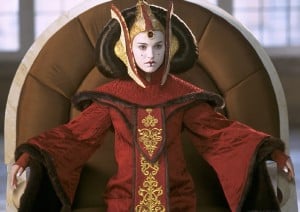
And while Leia commands the rebel forces, she also puts the rebellion on hold to save her man, a fact Cracked comically calls out.
I sometimes internally debate who is the stronger character, but this kind of either/or thinking – Padmé or Leia – is just another consequence of such limited representation.
Had Lucas thoughtfully included just a third or (dare I go there?) fourth (gasp!) major female character, the false either/or dichotomy crumbles.
Some inclusion is something, but more is better. And of course, it’s going to take more than numbers to fix the representation of women in the first six films.
2. They Don’t Let the Women Do Jack Jane
In one survey of the “10 Strongest Female Characters” of Star Wars, only two appeared in the movies. (The majority of them debuted in comics.) A galaxy of strong women exists, yet they disappear when it comes to big-budget blockbusters.
I re-watched all six movies to prepare for this article, and I’m fairly certain female Jedi use the force exactly zero times.
Okay, Leia – daughter of Darth “Off-the-Chart Midi-Chlorians” Vader – manages to pull off some mild telepathy at the end of Empire Strikes Back, but she is not a Jedi and could have managed similar communication with a cellular flip phone.
If you scoot yourself within inches of your screen, you may catch a glimpse of a female Jedi or two wielding a lightsaber, but never the force.
The filmmakers need to do more than pack the casting list chock full of complex women (they don’t even always need to be strong, so long as male characters have similar shortcomings). They need to ensure that these women actually do something.
After all, these are action films, not princess films. These are the characters that kids will dress up as for Halloween and role-play in invented adventures. Let these kids emulate strength, not passivity.
After 800 minutes of Star Wars, the one female Jedi who most sticks out in my mind – the one the camera remains trained on the longest (11 seconds) – gets killed by Stormtroopers.
Outfitted in ample bluish-green cleavage, she quickly falls dead, putting up none of the fight mustered by her male counterparts.
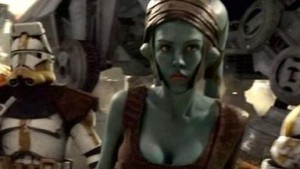
And the bluish-green cleavage leads me to my next point.
3. They Heavily Objectify Women
Star Wars is not some reprehensible Axe body spray ad or Carl’s Jr. commercial.
Yet objectified women – often times not-exactly-human humanoids (as if that makes it okay) – are scattered everywhere in the backgrounds of first six movies: in diners, cantinas, battlefields, crime lord lairs, and even Jedi temples.
As advertising critic Jean Kilbourne has asserted for decades, the media’s rampant objectification of women is a form of dehumanization, a way of stripping women of their humanity until they become—well—objects.
According to Ms. Magazine, objectification “has been linked to problems with mental health, eating disorders, body shame, self-worth and life satisfaction, cognitive functioning, motor functioning, sexual dysfunction, access to leadership, and political-efficacy.”
Such routine objectification in our media invariably contributes to a climate in which violence against women becomes intolerably common.
Furthermore, in an interview on NPR, Carrie Fisher revealed that her metal bikini from Return of the Jedi did not at all conform to her skin. As a result, Boba Fett, standing behind her on set, could see “all the way to Florida.”
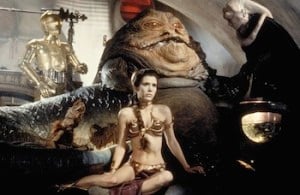
Aside from doughnut-hair Leia, bikini-clad Leia is likely the image that people most associate with Fisher from these films, revealing the insidious power of objectification.
Doesn’t it make far more sense for us to remember her more as a rebel commander than a near-naked captive?
4. They Exclude More Than Just Women and People of Color
While I often default to analyses of racism and sexism, there are other important lenses to put to work.
For example – and I am bracing myself from reader outcry here – an LGBTQIA+ lens reveals that all six films grossly exclude queer characters.
“What does sexual identity have to do with intergalactic civil war?” you may protest.
My response: George Lucas put sexual identity on the table the moment he made romance key plot points of both trilogies: first between Anakin and Padmé, and second, between Leia and Han Solo.
Following an era of an unprecedented expansion of queer rights since the release of the very first film in 1977, it’s time straight relationships finally share the stage with queer ones.
If J.K. Rowling can slip one gay central character into her magical – but still British – world of Harry Potter (though far more subtly than many of us would have preferred), then J.J. Abrahams can manage a similar feat in an entirely imagined universe.
Furthermore, after a year in which the mainstream media has finally picked up on transgender issues, we are reminded that many other groups deserve representation in these imaginative space adventures.
5. They Racialize the Antagonists and (Attempted) Comic Relief
Much has been written about the racism of Star Wars, even in mainstream sources like Time Magazine, so I’ll just briefly summarize a few.
While the heroes of Star Wars are nearly completely White, the antagonistic Nemoidians of the Trade Federation have Asian characteristics (accent, dress), the slave trader Watto resembles a Jewish caricature (accent, hat, nose, greed), and let’s not forget the heavily Caribbean-influenced “comic” relief, Jar Jar Binks and the Gungans.
As I argue in a previous article, such patterns reinforce a racist system, one that puts (non-Jewish) White people on a pedestal and relegates people of color to a second-class status.
And how does the endless supply of Stormtrooper clones fits into this pattern? The actor filling the armor of every single Stormtrooper, Temuera Morrison, has Māori ancestry, making him far darker than the White heroes of the films.
Is it possible our internalized racism allows us to better cope with the killing of hundreds and hundreds of Stormtoopers over the course of multiple movies? Could this country’s long history of dehumanizing Black and Brown people play a role here?
Imagine the cognitive dissonance that would ensue if Chris Hemsworth or Chris Evans – or even Jennifer Lawrence – donned the Stormtrooper armor only to be routinely killed. It is practically unthinkable. The brain just can’t make that jump.
It is fitting that Disney now owns the Star Wars franchise, as Disney has long mastered the art of ensuring the antagonists could never be confused for the protagonist: Ariel is far lighter than Ursula. Aladdin is far lighter than Jafar. Simba is far lighter than Scar. Mulan is far lighter than Shan Yu.
In constructing the Star Wars universe, George Lucas has said, “Look around you. Ideas are everywhere.” That may be true, but we don’t need to include the ideas based on offensive stereotypes and racist patterns.
I can only hope that actor John Boyega is only disguised as a Stormtrooper, as casting another antagonist of color only extends the pattern into 2015.
6. They Show the Jedi to Be Weapons for the Rich and Powerful
The Jedi are super-powered contradictions, as cool as they are confusing.
Like Batman, they are too evolved to use “uncivilized” handguns. At the same time, they are not above using a lightsaber to routinely lop off arms, not to mention decapitate.
(Just ask little Boba – who is shown picking up his father’s severed head – how “civilized” the lightsaber is.)
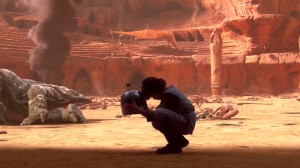
But it’s not just their violence that’s off-putting – it’s the roles they play in the prequels. Their company line is “service to the Senate.” Most often, this service entails commanding the military and protecting the rich and wealthy.
Meanwhile, the thriving slavery on Tatooine remains off the Jedi Council’s agenda.
And while Jedi profess an aversion to attachment and possession (with the exception, apparently, of their weapons), the Jedi Council confers in a towering spire with penthouse-like views of Coruscant.
These are the galaxy’s spiritual leaders? True, they are called Jedi Knights, but I’m just not buying spirituality intertwined with violence.
Imagine if it was discovered that the Dalai Lama secret served on a Tibetan black-ops strike force? His messages of peace and compassion could never resonate with the same authenticity.
It doesn’t add up in either universe.
If our children are going to emulate a new generation of Jedi, let their actions finally match their rhetoric of peace.
I’m not proposing that they give up their lightsabers entirely (especially considering the cool sounds they make), but the Jedi could at least find a more creative way to fight injustice than perhaps the greatest injustice of all: war.
***
In the spring of 2014, when the cast list for Star Wars: The Force Awakens was initially announced, it looked as if the franchise had corrected few, if any, of these shortcomings. Star Wars was going to continue to be Star Battle-of-the-Mostly-White-Boys.
Like the response to the Black Stormtrooper, outrage followed, but this time coming from fans wanting a more inclusive galaxy, not a more racist, misogynistic one.
Shortly after, the filmmakers announced the casting of two more women, Lupita Nyong’o and Gwendoline Christie. These welcome additions provide a New Hope that the franchise could indeed do better in 2015.
In case they don’t, get your hashtags and online petitions ready. Or, for a more direct approach, send your comments straight to Disney Movies. It will likely take some serious force – born of an engaged citizenry, not midi-chlorians.
[do_widget id=”text-101″]
Jon Greenberg is a Contributing Writer for Everyday Feminism. He is an award-winning public high school teacher in Seattle who has gained broader recognition for standing up for racial dialogue in the classroom — with widespread support from community — while a school district attempted to stifle it. To learn more about Jon Greenberg and the Race Curriculum Controversy, visit his website, citizenshipandsocialjustice.com. You can also follow him on Facebook and Twitter.
Search our 3000+ articles!
Read our articles about:
Our online racial justice training
Used by hundreds of universities, non-profits, and businesses.
Click to learn more





